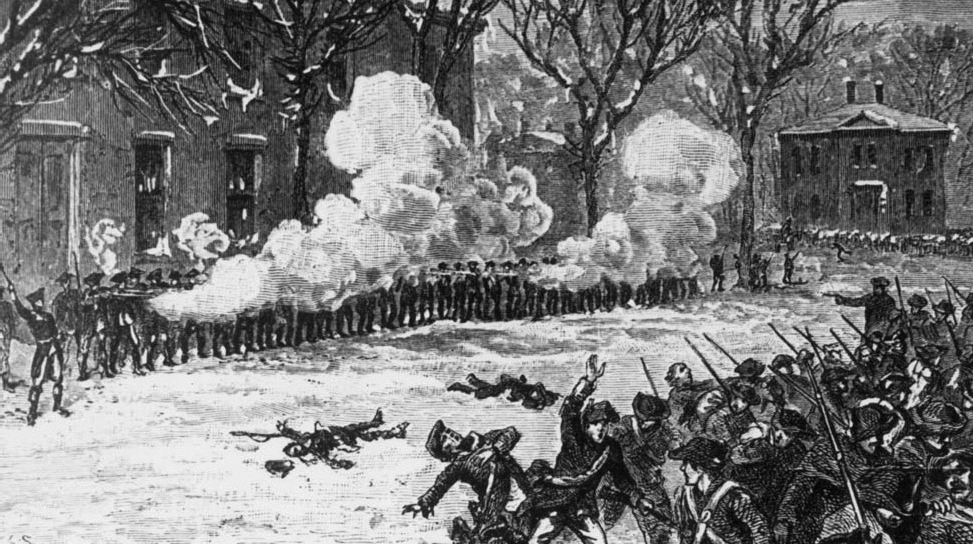
Assault on the Springfield Armory. By Shockabrah, Own Work, Wikimedia Commons.
Possibly the most well-known event during Shays’ Rebellion was his assault on the Springfield Armory which took place on January 25, 1787.
After the Early Rumblings that took place across western and central Massachusetts, the largest group of insurgents that was formed during Shays’ Rebellion was located at the Springfield Armory. Almost 2,000 dissatisfied rural farmers came together in order to stop the meeting of the Supreme Court. Upon arrival at the armory, Daniel Shays and ally, Eli Parsons, along with some 1,500 insurgents convened at the Springfield Armory with Luke Day and his 400 followers in West Springfield. Waiting for the insurgents was a force of about 1,100 militia men led by General William Shepard [1].
From the 18th of January, 1787, the insurgents of Daniel Shay and the troops of General Shepard stood facing off near the armory. Both groups dreaded the idea of conflict, but both stood ready. For three days the Supreme Court met, but came to no conclusion on their deliberations. Shays and his men saw this as a victory. James Bowdoin, the then governor of Massachusetts, however, saw this as an “insurrection” and ordered that a force of more than four thousand volunteer troops be assembled to confront Shays and his men. The order was sent out to Commander Benjamin Lincoln, one of the most distinguished veterans of the American Revolution [2]. Lincoln was able to gather around 4,400 men – including horses, footman, and artillery – between Boston and Springfield, however, the U.S. government had troubles paying these men for their sixty-day enlistment. Governor Bowdoin realized that the state coffers were empty and there was no way of paying the men, so he turned to the wealthy people of Boston to pay what was needed [3]. Bowdoin also ordered that Shepard begin communicating and working with the local law enforcement in Springfield to make sure the rebels did not capture the armory before Lincoln arrived with the reinforcements [4].
By the time of January, 1787, word had reached Philadelphia, Pennsylvania and George Washington was quoted as having said:
“It was but the other day that we were shedding our blood to obtain the Constitutions under which we now live – Constitutions of our own choice and making – and now we are unsheathing the sword to overturn them.” [5]
On the 25th of January, before the arrival of Lincoln and his men, violence broke out between Shays’ rebels and the Shepard and his militia. The rebels attacked Shepard and his men seriously wounding one continental soldier. Meanwhile, four rebels were killed and the reset were forced to retreat [6]. Lincoln would arrive at the armory on the 27th and would begin his advance against the rebels [7].
The defeat at the armory would be the beginning of the end for the rebellion. So, the retreating troops, accompanied by Shays and Parsons, would begin Heading West.
_____________________________________________________________________________________________________________________________________________________________
[1] Richard D. Brown, “Shays’ Rebellion and its Aftermath: A View from Springfield, Massachusetts, 1787,” The William and Mary Quarterly 40, no. 4 (1983): 600.
[2] Edward Everett Hale Sr., The Story of Massachusetts, Edward Everett Hale Sr., (Boston: D. Lathrop Company, 1891), 305-306.
[3] Rachel R. Parker, “Shays’ Rebellion: An Episode in American State-Making,” Sociological Perspectives 34, no. 1 (1991): 101.
[4] Walter A Dyer, “Embattled Farmers,” The New England Quarterly 4, no. 3 (1931): 471.
[5] Ibid.
[6] Parker, 101.
[7] Hale Sr., 308.